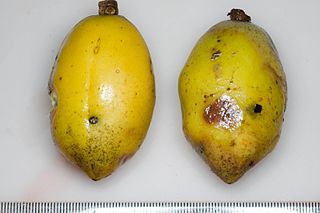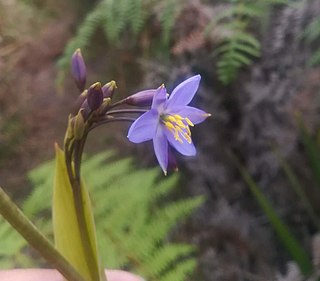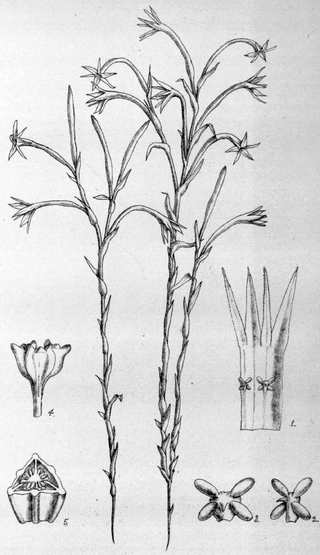Astrococcus is a genus of plant of the family Euphorbiaceae first described as a genus in 1854. It contains only one known species, Astrococcus cornutus, native to neighboring states of identical names, Amazonas State in southern Venezuela and Amazonas State in northwestern Brazil.
Haematostemon is a genus of plant of the family Euphorbiaceae first described as a genus in 1919. It is native to northeastern South America.
- Haematostemon coriaceus(Baill.) Pax & K.Hoffm. - Amazonas State in S Venezuela
- Haematostemon guianensisSandwith - Potaro-Siparuni region of Guyana

Glycydendron is a genus of plants, under the family Euphorbiaceae first described as a genus in 1922. It is native to South America.
- Glycydendron amazonicumDucke - French Guinea, Suriname, Guyana, Ecuador, Peru, Bolivia, northwestern Brazil, possibly Colombia
- Glycydendron espiritosantenseKuhlm, - State of Espirito Santo in Brazil
Dendrothrix is a plant genus of the family Euphorbiaceae first described as a genus in 1996. It is native to southern Venezuela and northwestern Brazil.
- Dendrothrix multiglandulosaEsser - Amazonas State in Venezuela
- Dendrothrix wurdackiiEsser - Amazonas State in Brazil
- Dendrothrix yutajensis(Jabl.) Esser - Amazonas State in Brazil; Amazonas & Bolívar States in Venezuela
Pseudosenefeldera is a plant genus of the family Euphorbiaceae first described as a genus in 2001. It contains only one known species, Pseudosenefeldera inclinata, native to Panama and to northern and west-central South America.

Aspidosperma ulei is a timber tree native to Brazil, Venezuela, Colombia, Guyana, and Suriname.
Triuris hyalina is a species in genus Triuris. It is a tiny flowering plant no more than a few cm tall, lacking chlorophyll and obtaining its nutrients from fungi in the soil. It is known from Brazil, Suriname, Guyana, Colombia, Venezuela.
Thoracocarpus is a genus of plants first described as a genus in 1958. It contains only one known species, Thoracocarpus bissectus a hemiepiphytic vine. It is native to Costa Rica, Panama, Cuba, Trinidad and Tobago, and South America.

Aganisia pulchella is a species of orchid native to Trinidad, French Guiana, Suriname, Guyana, Venezuela, Brazil. It is the type species of the genus Aganisia.
Steirachne is a genus of South American plants in the grass family.

Catopsis floribunda is a species in the genus Catopsis. This species is native to the West Indies, Venezuela, Honduras, Oaxaca, and Florida.
Polyotidium is a monotypic genus of flowering plants from the orchid family, Orchidaceae. The sole species is Polyotidium huebneri, native to Colombia, Venezuela and Brazil.

Amasonia is a genus of plants in the family Lamiaceae, native to South America and to the island of Trinidad.
Soridium is a genus of parasitic plants in the Triuridaceae, lacking chlorophyll and obtaining nutrients from fungi in the soil. It contains only one known species, Soridium spruceanum, native to Brazil, Venezuela, Suriname, French Guiana, Belize and Guatemala.

Excremis is a genus of herbs in the family Asphodelaceae, first described as a genus in 1829. There are only one known species, Excremis coarctata, native to South America.
Achlyphila is a genus of plants in the Xyridaceae, first described as a genus in 1960. It contains only one known species, Achlyphila disticha, endemic to the Serranía de la Neblina National Park in the State of Amazonas in southern Venezuela, very close to the border with Brazil.
Aratitiyopea is a monotypic genus of flowering plants, in the family Xyridaceae containing the single species Aratitiyopea lopezii. The genus was erected and described in 1984. This species is native to northern South America.

Campylosiphon is a genus of flowering plants in the Burmanniaceae, first described as a genus in 1882. It is native to tropical western and central Africa, as well as northern South America.
Chromolucuma is a genus of plants in the family Sapotaceae described in 1925.
Thurnia is a group of herbaceous plants described as a genus in 1883.






